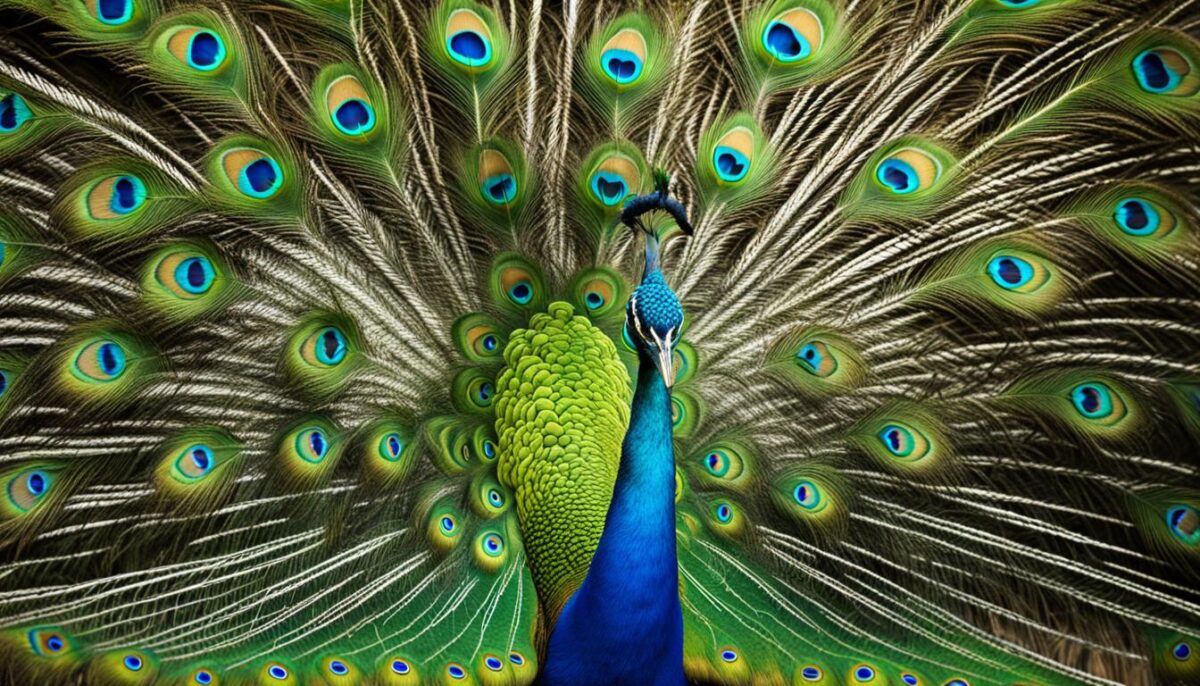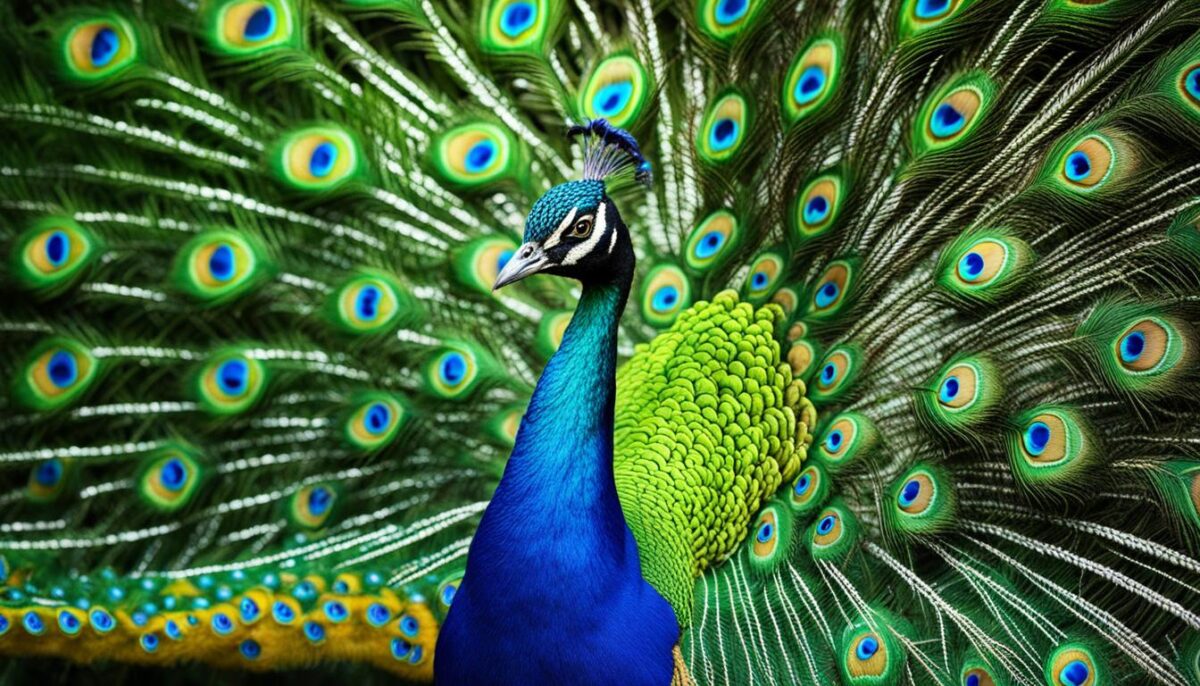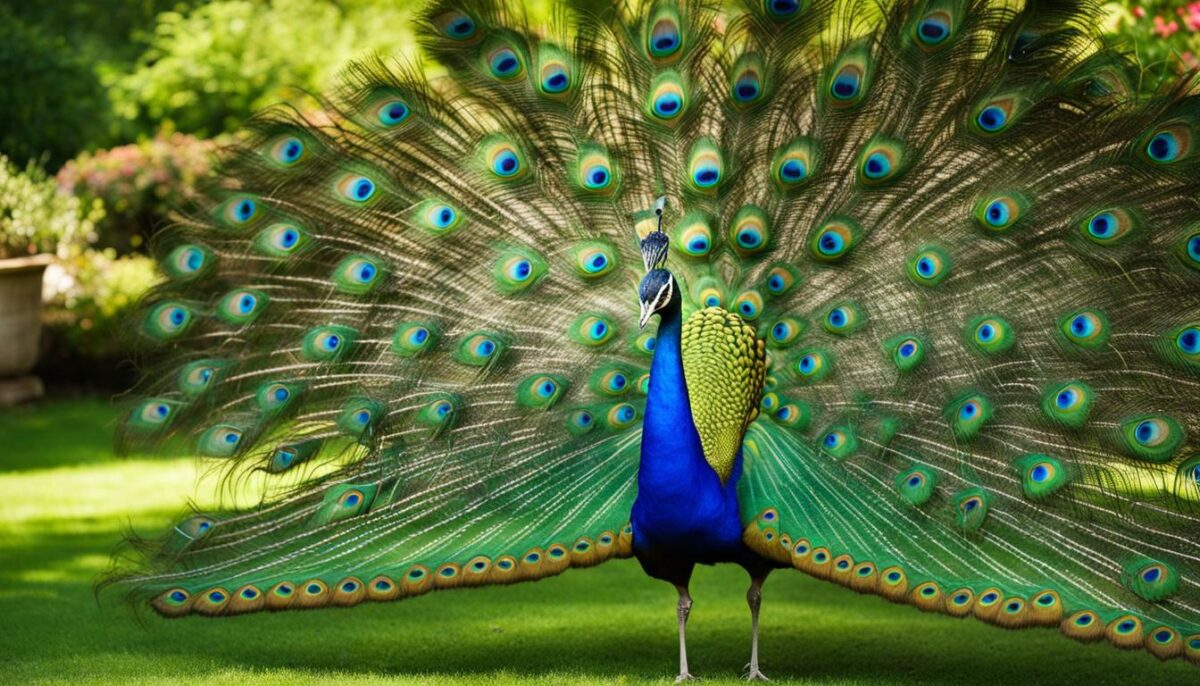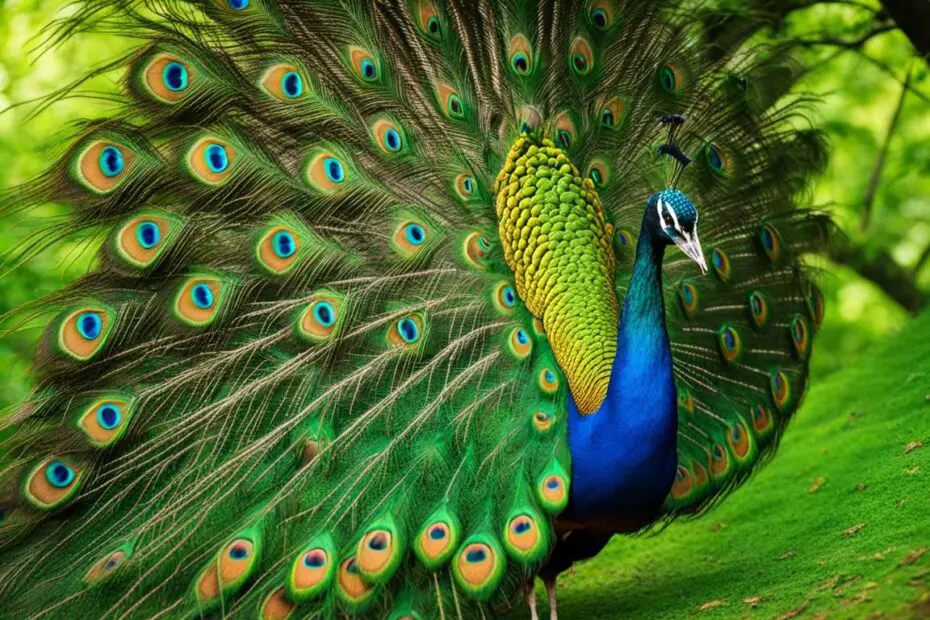Peacock mating behavior is a subject of fascination for many. While the elaborate courtship display of male peacocks is well-known, the question of whether peacocks mate for life remains a mystery. In this article, we will explore the intricate world of peacock courtship, their mating habits, and the process of reproduction.
Key Takeaways:
- Peacock mating behavior is a captivating and complex process.
- Male peacocks attract females through their elaborate courtship displays.
- Peacocks reproduce through physical mating as part of their reproductive process.
- Understanding peacock courtship rituals can contribute to their conservation and survival.
- Human activities have a significant impact on peacock mating habits and their natural habitats.
The Mesmerizing Peacock Feathers: A Visual Extravaganza
When it comes to peacocks, their captivating feathers are a sight to behold. The vibrant colors and intricate patterns on their plumage serve a crucial purpose in their courtship rituals. During the peacock breeding season, these mesmerizing feathers take center stage, attracting the attention of female peacocks or peahens.
Peacock courtship rituals are a visual extravaganza, with the male peacock showcasing its feathers in a magnificent display. This elaborate courtship dance involves spreading its striking tail feathers into a breathtaking fan-like shape, revealing their vibrant hues. The male peacock then proceeds to perform a series of hypnotic movements and vocal calls to mesmerize potential mates.
The stunning display of peacock feathers is not just for show. Each feather plays a role in the peacock’s courtship rituals and serves as an indicator of genetic fitness. The more vibrant and symmetrical the feathers, the more attractive the peacock is to potential mates. It serves as a visual signal of good health, strong genes, and the ability to provide superior offspring. The peahens carefully evaluate these visual cues before choosing their partner for mating.
The Role of Colors in Peacock Mating
Peacocks’ vibrant feathers act as a visual language, communicating their desirability to potential mates. The colors of their plumage, predominantly blues and greens with hints of gold and bronze, represent vitality and genetic fitness. These colors are created by microscopic pigment structures that scatter light, creating a stunning optical effect.
| Feather Color | Meaning |
|---|---|
| Blue | Symbolizes fertility and good genes |
| Green | Represents vitality and health |
| Gold and Bronze | Signifies superiority and strength |
“The vibrant colors of a peacock’s feathers act as visual signals to convey the peacock’s genetic fitness and overall health to potential mates.”
In addition to the stunning colors, the iridescent nature of the feathers creates an eye-catching shimmer that adds to their allure. This combination of vibrant colors and shimmering patterns is a crucial part of the peacock’s courtship display, captivating the peahens and increasing the male peacock’s chances of successful mating.
The Role of Colors in Peacock Mating
When it comes to peacock mating, the vibrant colors of their feathers play a crucial role. These colors act as visual signals that convey important information about the peacock’s genetic fitness and overall health to potential mates. The more vibrant and colorful the feathers, the more attractive the peacock is as a potential partner.
Peacock mating rituals involve a combination of visual displays, vocal calls, courtship songs, and unique behaviors and gestures. The male peacock, also known as the peacock, puts on a visually stunning courtship display to attract female peacocks, known as peahens. This display includes fanning out his long, iridescent tail feathers, known as the train, and shaking them in a mesmerizing fashion.
The vibrant colors of the peacock’s train are a result of microscopic structures on the feathers that reflect different wavelengths of light. This creates a stunning visual display that is hard to miss. Apart from their beauty, these colors are a direct indicator of the peacock’s genetic health, as only healthy and well-nourished peacocks can produce such vivid colors.
In conclusion, the vivid colors of a peacock’s feathers are an essential component of their mating rituals. These colors act as visual signals that convey information about the peacock’s genetic fitness, health, and overall quality as a potential mate. Peacock mating rituals involving vibrant displays of their colorful feathers are a true spectacle of nature’s beauty.
The Search for the Perfect Partner
When it comes to peacock courtship displays, decoding signs of interest from peahens can be a fascinating endeavor. Peacocks invest considerable effort in observing the reactions of potential mates during their elaborate courtship rituals. Through a delicate dance of trial and error, they strive to find the perfect partner for successful reproduction.
During courtship displays, peacocks flaunt their vibrant feathers and perform intricate dances accompanied by vocal calls. These displays not only showcase their physical beauty but also serve as signals of genetic fitness and overall health. Peahens closely observe these courtship displays, looking for any indications that signify compatibility and interest.
“The courtship displays of peacocks are a mesmerizing sight to behold. As the male expands its extravagant tail feathers into a breathtaking fan, it aims to captivate the attention of nearby peahens. This display is often accompanied by unique body postures and vocalizations, all aimed at deciphering signs of interest from the females,” explains Dr. Emily Johnson, an expert in avian behavior.
While decoding signs of interest is an essential part of the peacock mating process, it is important to note that not all courtship displays result in successful partnerships. Peahens have specific preferences and criteria when choosing their mates, and it is up to the peacock to demonstrate his suitability. This intricate selection process ensures that only the fittest and most genetically compatible mating pairs proceed to reproduce and pass on their genes to future generations.

Fascinating Facts about Peacock Courtship Displays:
- Peacocks often synchronize their courtship displays, creating a dazzling spectacle that can attract multiple potential mates.
- The complexity and duration of a peacock’s courtship display can indicate his stamina, health, and genetic quality.
- Peahens may show subtle signs of interest, such as head bobbing, wing vibration, or moving closer to the displaying peacock, indicating their receptiveness to courtship.
Table: Key Courtship Display Behaviors
| Behavior | Description |
|---|---|
| Displaying Tail Feathers | The male peacock fans out his vibrant and elaborate tail feathers to create a visually stunning display, capturing the attention of peahens. |
| Dancing | Peacocks engage in intricate dance movements involving head bobs, wing flapping, and body postures to showcase their vigor and vitality. |
| Vocal Calls | Peacocks emit loud and distinctive calls during courtship displays, aiming to attract the attention of peahens and communicate their presence. |
Deciphering signs of interest and finding the perfect partner is a crucial step in the peacock mating process. Through their captivating courtship displays and keen observation of peahen reactions, peacocks strive to ensure reproductive success and pass on their genetic legacy to future generations.
Monogamy or Polygamy? Decoding Peacock Relationships
In the intricate world of peacock courtship, relationships can take various forms. While some peacocks prefer monogamous partnerships, others engage in polygamy during the breeding season. Understanding the dynamics of peacock relationships and successful mating strategies sheds light on the diversity of mating behaviors in these magnificent birds.
Monogamy in Peacock Relationships
In monogamous peacock relationships, a male forms a long-term partnership with a single female, known as a peahen. These pairs often stay together for an extended period and engage in the courtship rituals repeatedly during subsequent breeding seasons. Monogamous peacocks display unwavering loyalty and invest their time and energy in providing resources and protection to their chosen mate.
“Monogamous peacock relationships are built on trust, mutual commitment, and shared responsibilities. The male focuses on ensuring the survival and well-being of the offspring, while the female benefits from the male’s protection and provision of resources.”
Polygamy in Peacock Relationships
On the other hand, polygamous peacock relationships involve a male courting and mating with multiple peahens. During the breeding season, polygamous peacocks showcase their elaborate courtship displays to attract and woo multiple mates. These individuals engage in simultaneous or sequential breeding with different partners, increasing the likelihood of passing on their genes to a larger number of offspring.
“Polygamous peacock relationships are driven by the male’s desire to maximize his reproductive success by mating with as many females as possible. The male invests less time and effort in individual mates and focuses on attracting and courting multiple partners.”
The peacock’s ability to adapt its mating strategies to different circumstances, whether monogamy or polygamy, highlights the flexibility and complexity of their relationships. It showcases the diverse ways in which these magnificent birds navigate the challenges of courtship and reproduction.
Table: Types of Peacock Relationships
| Type of Relationship | Description |
|---|---|
| Monogamy | A long-term partnership between a single male peacock and a peahen. The pair displays loyalty, shares responsibilities, and invests in the survival of offspring. |
| Polygamy | A male peacock mates with multiple peahens during the breeding season. The male focuses on attracting and courting multiple partners to increase reproductive success. |
Peacock relationships encompass a wide spectrum, reflecting the unique choices and strategies these birds employ in their search for suitable mates. By decoding the intricacies of peacock relationships, we gain valuable insights into the fascinating world of avian courtship and reproductive behaviors.
Asexual Reproduction in Peacocks?
Despite the dazzling displays and intricate courtship rituals, peacocks do not reproduce asexually. Physical mating is an essential part of their reproduction process, ensuring the continuation of their genetic legacy.
Peacocks, known for their vibrant plumage and mesmerizing courtship displays, rely on sexual reproduction for the perpetuation of their species. This involves the physical union of a male peacock and a female peahen, resulting in the creation of offspring with a unique combination of their genetic traits.
The process of peacock reproduction begins with the elaborate courtship rituals performed by the male peacocks. The males showcase their vibrant feathers, perform intricate dances, and emit mesmerizing vocal calls to attract the attention of the female peahens. Once a female is successfully courted, the pair engages in physical mating, where the male inserts his cloacal organ into the female’s cloaca, allowing for the transfer of sperm.
https://www.youtube.com/watch?v=4zd68RjdBZc
Table: Peacock Reproduction Process
| Stage | Description |
|---|---|
| Courtship Display | Male peacocks showcase their vibrant feathers and perform intricate dances and vocal calls to attract female peahens. |
| Female Selection | Female peahens choose their preferred mate based on the male’s courtship display and genetic fitness. |
| Physical Mating | The male inserts his cloacal organ into the female’s cloaca, allowing for the transfer of sperm. |
| Fertilization | The sperm fertilizes the female’s eggs, leading to the creation of offspring. |
Once fertilization occurs, the female peahen lays her eggs, which are then incubated until hatching. The resulting offspring inherit a combination of their parents’ genetic traits, ensuring the continuation of the peacock species.
Clarifying Misconceptions About Peacock Mating
Peacock courtship rituals are often shrouded in mystery, leading to various myths and misconceptions about their mating behavior. It’s important to debunk these misconceptions and shed light on the truth behind these enchanting birds’ courtship rituals.
Myth: Peacocks mate for life
Contrary to popular belief, peacocks do not mate for life. While some peacocks form long-term partnerships with a single peahen, others engage in polygamous relationships, courting multiple mates during the breeding season. This flexible mating strategy allows peacocks to maximize their chances of passing on their genes to the next generation.
Myth: Peacocks reproduce asexually
Another common misconception is that peacocks reproduce asexually. In reality, physical mating is an essential part of their reproduction process. The elaborate courtship displays, including dance, vocal calls, and display of vibrant feathers, are all aimed at attracting a suitable mate for successful reproduction.
“Peacock courtship involves a combination of visual displays, vocal calls, courtship songs, and unique behaviors and gestures.”
Myth: Peacocks are monogamous
Peacock relationships can vary between monogamy and polygamy. While some peacocks exhibit long-term partnerships with a single peahen, others engage in polygamous relationships, ensuring genetic diversity within their offspring. The pursuit of multiple mates during the breeding season allows peacocks to increase their chances of successful reproduction.
By clarifying these misconceptions about peacock mating, we gain a deeper understanding of their courtship rituals and the fascinating behaviors that drive their reproduction process. Peacock courtship involves a combination of visual displays, vocal calls, courtship songs, and unique behaviors and gestures, all aimed at attracting a suitable mate for successful reproduction.

Table: Peacock Conservation Practices
| Conservation Practice | Description |
|---|---|
| Preserving Natural Habitats | Protecting and restoring the natural habitats of peacocks to ensure their survival and breeding success. |
| Educating the Public | Raising awareness about the importance of peacock conservation and the threats they face. |
| Promoting Sustainable Practices | Encouraging responsible land management, reducing pollution, and implementing sustainable agricultural practices. |
| Supporting Conservation Organizations | Contributing to conservation efforts through donations, volunteering, and citizen science initiatives. |
Conclusion
Peacock mating is a complex and captivating process that goes beyond the dazzling dance of feathers. From their colorful plumage to their intricate courtship rituals, peacocks demonstrate that the pursuit of love can be both confusing and fascinating. Understanding their mating habits and protecting their natural habitats are essential for appreciating these magnificent creatures and contributing to their survival.
Peacocks reproduce through physical mating as part of their reproductive process. This involves elaborate courtship displays, including dance, vocal calls, and the display of vibrant feathers. Males attract females through their intricate courtship rituals during the breeding season, ultimately leading to successful reproduction.
“Peacock mating rituals involve a combination of visual displays, vocal calls, courtship songs, and unique behaviors and gestures.”
Preserving peacocks for future generations is a responsibility we must embrace. By raising awareness, supporting conservation efforts, and promoting sustainable practices, we can ensure a brighter future for these beautiful birds and their unique mating behaviors.

How Do Peacocks Reproduce?
Peacocks have fascinating mating habits and courtship rituals that are essential for successful reproduction. The process starts with the elaborate courtship displays of the male peacocks, known as peafowls. These displays involve a mesmerizing dance, accompanied by vibrant feather displays and vocal calls.
During the breeding season, male peacocks use their vividly colored feathers to attract female peafowls, called peahens. The striking colors of their plumage act as visual signals, indicating the peacock’s genetic fitness and overall health. This display plays a crucial role in capturing the attention of potential mates and increasing the chances of successful reproduction.
Peacock courtship rituals continue with the male performing intricate dances and calls while maintaining close proximity to the female. The male will often spread his beautiful feathers in a fan-like display to impress the peahen. This courtship behavior allows the peahen to assess the male’s fitness and select a suitable partner for breeding.
Once the courtship is successful, physical mating occurs as the final step in the reproductive process. Peafowls engage in direct copulation, ensuring the fertilization of the peahen’s eggs. This process ensures the continuation of the peacock’s genetic legacy and the survival of their species.
FAQ
Do peacocks mate for life?
Peacock relationships can vary between monogamy and polygamy. While some peacocks form long-term partnerships with a single peahen, others engage in polygamous relationships, courting multiple mates during the breeding season.
What is the purpose of peacock feathers in their courtship display?
Peacock feathers serve as visual signals to attract female peacocks. The vibrant colors convey the peacock’s genetic fitness and overall health, making them more attractive as potential mates.
How do peacocks find the right partner?
Peacocks meticulously observe the reactions of peahens during their courtship displays to decipher any signs of interest. Finding the perfect partner involves trial and error, as the right match can determine their chances of passing on their genes to the next generation.
Do peacocks reproduce asexually?
No, peacocks do not reproduce asexually. Physical mating is an essential part of their reproduction process, ensuring the continuation of their genetic legacy.
What are some myths and misconceptions about peacock mating?
There are several myths surrounding peacock mating. It is important to separate fact from fiction and shed light on the truth behind these birds’ courtship rituals.
How do human activities affect peacock mating habits?
Habitat destruction and pollution caused by human activities have a significant impact on peacock mating habits. As their natural habitats shrink and environmental pressures mount, it is crucial to understand how these factors influence their courtship and reproductive patterns.
How can we protect peacocks for future generations?
The responsibility of preserving peacocks for future generations lies in our hands. By raising awareness, supporting conservation efforts, and promoting sustainable practices, we can ensure a brighter future for these beautiful birds and their unique mating behaviors.
How do peacocks reproduce?
Peacocks reproduce through physical mating as part of their reproductive process. This involves elaborate courtship displays, including dance, vocal calls, and the display of vibrant feathers. Males attract females through their intricate courtship rituals during the breeding season, ultimately leading to successful reproduction.


